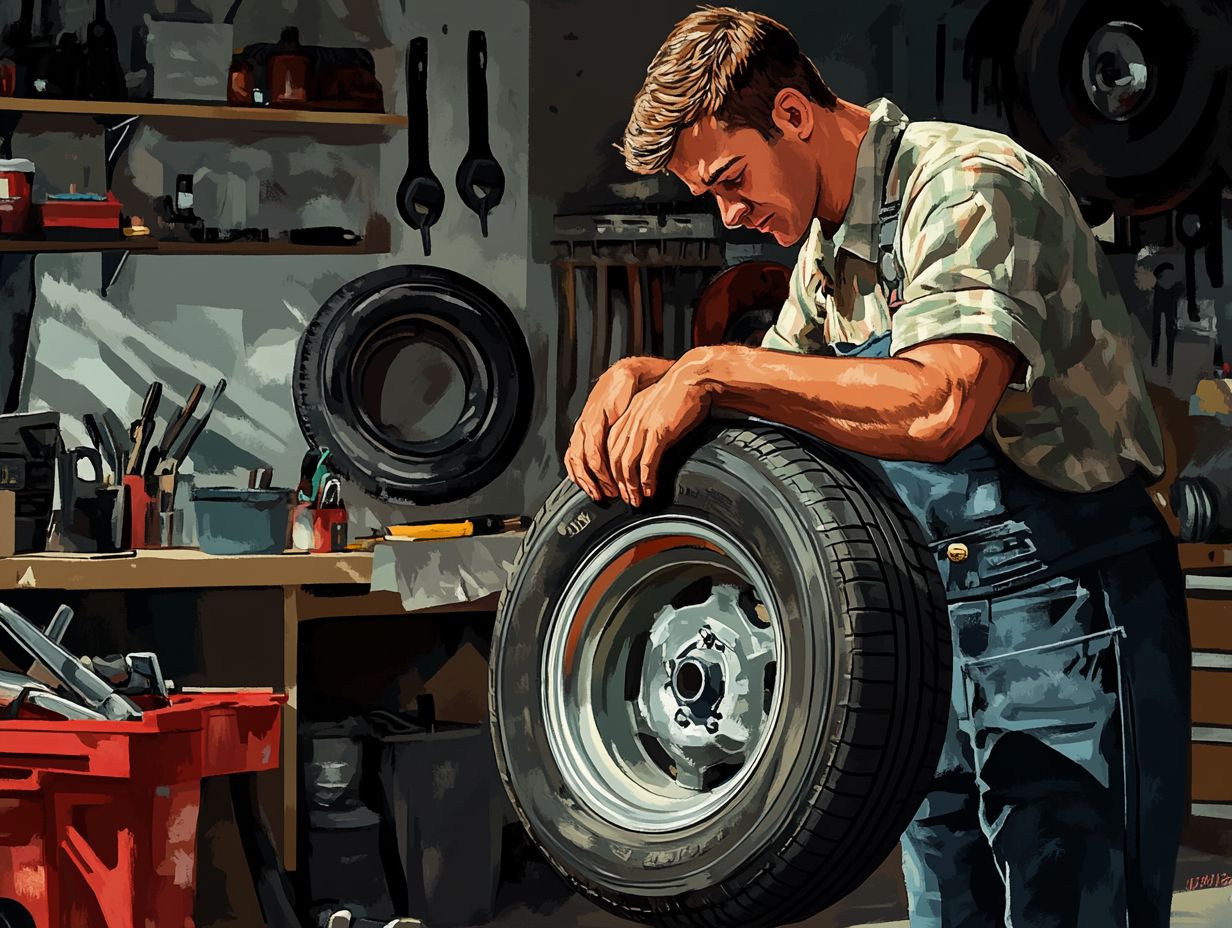5 Steps for Common Tire Repairs
Tire troubles can throw a wrench in your plans. But mastering common repairs can save you both time and money!
This guide outlines essential steps to help you identify tire problems, gather the necessary tools, safely remove the tire, and execute effective repairs with confidence.
You ll also discover valuable tips for proper reinstallation and preventative maintenance to keep your tires in peak condition.
Ready to roll up your sleeves? Let s dive into tire repairs!
Contents
- Key Takeaways:
- 1. Identify the Problem
- 2. Gather Necessary Tools and Materials
- 3. Remove the Tire from the Vehicle
- 4. Repair the Tire
- 5. Reinstall the Tire and Test It
- What Are the Most Common Tire Problems and How Can They Be Repaired?
- Frequently Asked Questions
- What are the 5 steps for common tire repairs?
- Is it safe to repair a punctured tire?
- Wondering if you can repair a tire with a sidewall puncture?
- What is the difference between patching and plugging a tire?
- Can I repair a tire with a tread depth below the legal limit?
- How long does a tire repair usually take?
Key Takeaways:

- Identify the problem with your tire before attempting any repairs.
- Gather the necessary tools and materials before beginning the repair process.
- Follow proper steps and safety precautions when removing, repairing, and reinstalling a tire.
1. Identify the Problem
Identifying the problem is your first and most crucial step in tackling tire issues. This is especially important when faced with a flat or damaged tire that can disrupt your road trip.
Look closely at the tire’s outer surface to pinpoint any punctures or foreign objects that may have caused the flat. Assess the severity of the damage. This identification helps you determine the type of repair required and ensures you’re equipped with the right tools and procedures, just as you would when following 5 tips for common windshield repair.
Start by examining the tread and sidewalls for any visible cracks, bulges, or punctures. It s also important to check for foreign objects, like nails or shards of glass, that might be lodged in the tire. These can lead to slow leaks or sudden deflation if not addressed promptly.
Using a tire pressure gauge, a tool used to measure air pressure, allows you to measure the air pressure accurately. This is vital for maintaining optimal tire performance. Be sure to refer to your vehicle s manual for specific metrics regarding appropriate tire pressure. This ensures both safety and fuel efficiency as you drive.
2. Gather Necessary Tools and Materials
Before starting any tire repairs, gather all the necessary tools and materials. Ensure your tire repair kit is comprehensive, including essentials like a tire plug kit, a lug wrench, and a reliable car jack or hydraulic lift.
These tools are vital for efficiently managing emergency repairs. This is especially true during a road trip, where being self-sufficient is key!
A well-prepared tire changing kit can be the deciding factor between a swift fix and a long wait for roadside assistance.
Equipping yourself with a well-stocked emergency kit is equally important. It should contain items like adhesive for sealing minor punctures and soap and water for cleaning the area before you start repairs. Keeping everything clean ensures a strong bond with the plug or patch.
Don t overlook the importance of having a tire pressure gauge close at hand. Regularly checking your tire pressure is essential for optimal performance and safety on the road. By monitoring tire pressure before any journey, you can boost fuel efficiency and extend the lifespan of your tires.
3. Remove the Tire from the Vehicle
Removing a tire from your vehicle requires a focus on safety and the right tools. You ll need a sturdy car jack and a reliable lug wrench to ensure your vehicle is lifted correctly and stable on solid ground.
Follow your vehicle manual s instructions to avoid injuries and make the tire change as seamless as possible. This step is essential not just for efficiency, but also for your overall safety while performing the repair!
Before diving in, make sure your vehicle is parked on level ground to prevent it from rolling away. Engage the parking brake and place wheel chocks behind the opposite tires for extra security.
Once everything is set, carefully loosen the lug nuts slightly while the tire remains on the ground. This little trick will make the next steps much easier!
When you lift the vehicle with the jack, ensure it s positioned correctly at the designated lift points. After raising it, give the vehicle a gentle shake to confirm it s stable.
Remember to work methodically, and always keep safety as your top priority throughout the entire process!
4. Repair the Tire

Repairing your tire is crucial. It involves identifying damage like punctures or leaks.
A tire repair kit with plugs and patches can bring your tire back to life. Use glue carefully and follow repair methods for lasting results.
By learning this repair process, you enhance your tire’s performance and lifespan. This leads to better road safety.
You can choose between DIY methods or professional help. If you want to handle repairs yourself, a kit with tools such as a reamer (to widen holes) and an insertion tool (to place plugs) is essential.
Start by inspecting and cleaning the damage. Then, apply a plug or patch for a secure fit.
For complex damage, it’s best to seek professional help. Experts can assess tire integrity and spot hidden risks.
5. Reinstall the Tire and Test It
Reinstalling your tire correctly is just as important as removing it. Ensure your spare tire is securely fastened and follow safety precautions to avoid injuries.
After reinstalling, check the tire pressure with a monitor. This ensures optimal performance before your test drive.
Align the tire with the wheel hub and slide it into place. Hand-tighten the lug nuts for proper alignment before using a wrench.
Once secure, use a torque wrench to tighten the nuts according to the manufacturer’s specifications. This guarantees long-term safety while driving.
After confirming all connections are secure, use a tire pressure gauge to check air pressure levels. Make sure they match the recommendations.
Only then should you go on a short test drive. This is your moment to see how well everything works together!
What Are the Most Common Tire Problems and How Can They Be Repaired?
As a vehicle owner, understanding common tire problems is essential. Flat tires, punctures, and improper air pressure can greatly affect your driving experience.
Watch for signs like noticeable air loss or uneven tread wear. These can compromise your vehicle’s stability.
Addressing these issues promptly enhances safety and prolongs tire life. For instance, knowing the steps to take after a flat tire can help ensure effective repair methods, including patching punctures and regularly checking air pressure.
Regular inspections help identify potential issues before they escalate. Prioritize proactive maintenance to enjoy a smoother, safer ride.
What Tools and Materials Are Needed for Tire Repairs?
To repair tires effectively, you need the right tools. A complete tire repair kit, including a tire plug kit, lug wrench, and a reliable car jack, is invaluable during emergencies.
A well-stocked emergency kit and a tire pressure gauge can help you address tire issues quickly. This preparation ensures you re ready for any situation on the road.
Include a set of tire levers to remove tires safely from rims. A tire inflator or compressor is essential for quick re-inflation, especially if you have a flat.
A flashlight is crucial for nighttime repairs, while extra valve stems and a patching kit come in handy for sealing punctures.
Keeping these tools handy saves time and boosts your confidence. You ll handle unexpected issues with ease, making every trip more enjoyable.
How Can One Safely Remove a Tire from a Vehicle?

Removing a tire safely is a vital skill. You need the right tools, like a car jack and lug wrench, plus a commitment to safety.
Position the car jack correctly to keep your vehicle stable. This reduces risks and improves your efficiency in changing tires.
Before you start, conduct some pre-removal checks. Ensure your vehicle is parked on a level surface, the parking brake is engaged, and the area around the vehicle is clear.
When using the car jack, position it under the manufacturer s recommended lift points, steering clear of any movable parts. Remember to employ jack stands after raising the vehicle for that extra layer of support.
Don t forget to wear safety goggles and gloves to shield yourself from debris. Keep bystanders at a safe distance to avoid any unforeseen accidents. With these practices in mind, you ll find the entire process easier and much safer.
What Are the Different Methods for Repairing a Tire?
Different tire repair methods suit the type and severity of the damage. Common techniques include puncture repairs utilizing a tire repair kit equipped with plugs and patches, along with tips for quick common car repairs.
Understanding which repair method to apply is essential. Improper techniques can lead to recurring issues and jeopardize your safety.
By familiarizing yourself with these methods, you can elevate your DIY repair skills and ensure effective maintenance of your tires, including following 5 tips for DIY common car repairs.
When deciding between plugs and patches, consider the location and size of the puncture. Plugs work well for small punctures on the tread, typically no larger than 1/4 inch. For larger or more serious damage, especially when the tire’s integrity is in question, patches are the more effective choice.
Always conduct a thorough inspection of the tire. If the damage is on the sidewall or affects the tire’s structure, it’s wise to seek a professional replacement rather than attempting a DIY fix. Also, keep in mind any potential warranty implications associated with tire repairs, and choose the method that aligns best with performance and safety standards.
How Can One Properly Reinstall a Tire onto a Vehicle?
Reinstalling a tire onto your vehicle is not just about securing it. It s a meticulous process that demands attention to safety precautions. Make sure the spare tire is aligned correctly. All lug nuts should be tightened to the manufacturer s specifications. This proactive approach can prevent future tire issues and significantly enhance your road safety.
Adhering to these guidelines contributes greatly to the longevity and effectiveness of your tires. Before installation, it s essential to assess the tread depth and condition of the tire, as these factors directly influence handling and fuel efficiency. Start by securely lifting the vehicle with a jack to establish a safe working environment. As you align the tire, pay close attention to the tread pattern and ensure it matches the wheel direction.
When tightening the lug nuts, remember to follow a star pattern. This method ensures even pressure distribution, which is vital for maintaining balance. After installation, a quick test drive will help you check for any vibrations or noises that could indicate potential issues requiring further inspection.
What Are Some Tips for Maintaining Tire Health and Preventing Future Repairs?
Maintaining tire health is crucial for your safety and fuel efficiency. Embracing effective tire maintenance practices can significantly minimize the chances of future repairs. Regularly checking tire pressure using a tire pressure monitor, rotating your tires, and scheduling professional inspections can extend tire life and enhance performance. By following these driving tips, you can ensure a safer and more efficient driving experience.
These essential checks include conducting daily visual inspections for any signs of wear or damage, such as cracks and bulges. Weekly assessments of tread depth can provide insight into your tire condition, while monthly alignments and balances promote even wear and optimal handling.
Consistently engaging in these practices not only safeguards you against unexpected breakdowns but also contributes to better fuel efficiency, ultimately saving you money at the pump. Proactively caring for your tires ensures a smooth and safe journey! Start your tire inspection today for a safer drive!
Frequently Asked Questions

What are the 5 steps for common tire repairs?
- Assessing the damage
- Removing the tire from the wheel
- Patching or plugging the puncture
- Re-inflating the tire
- Re-mounting the tire onto the wheel
Is it safe to repair a punctured tire?
If the puncture is within the repairable area and the damage is not too severe, it is generally safe to repair a punctured tire. However, it is always recommended to have a professional assess the damage and make the repair to ensure safety.
Wondering if you can repair a tire with a sidewall puncture?
No, a tire cannot be repaired if it has a puncture on the sidewall. This is because the sidewall is a crucial part of the tire’s structural integrity, and a repair in this area can compromise its safety.
What is the difference between patching and plugging a tire?
Patching a tire involves removing the damaged area and replacing it with a rubber patch, while plugging simply inserts a rubber plug into the puncture. Patching is considered a more permanent and reliable repair, while plugging is a temporary solution.
Can I repair a tire with a tread depth below the legal limit?
No, it is not safe or legal to repair a tire with a tread depth below the legal limit. This is because the tire’s tread is crucial for proper traction and handling, and a worn-out tread can lead to dangerous driving conditions.
How long does a tire repair usually take?
The time it takes to repair a tire can vary depending on the severity of the damage and the expertise of the person making the repair. On average, a tire repair can take anywhere from 20 minutes to an hour.
Remember, regular tire checks ensure your safety and save you money!






